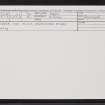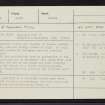Following the launch of trove.scot in February 2025 we are now planning the retiral of some of our webservices. Canmore will be switched off on 24th June 2025. Information about the closure can be found on the HES website: Retiral of HES web services | Historic Environment Scotland
Dundee, The Houff, Franciscan Friary
Friary (Medieval)
Site Name Dundee, The Houff, Franciscan Friary
Classification Friary (Medieval)
Alternative Name(s) Greyfriars' Monastery
Canmore ID 33459
Site Number NO43SW 11
NGR NO 4015 3030
Datum OSGB36 - NGR
Permalink http://canmore.org.uk/site/33459
- Council Dundee, City Of
- Parish Dundee (Dundee, City Of)
- Former Region Tayside
- Former District City Of Dundee
- Former County Angus
NO43SW 11 4015 3030.
(Name: NO 4012 3030) Supposed Site of Greyfriars Monastery (NR) (1260)
OS 1:500 plan, Dundee, Forfarshire, (1871)
A Franciscan friary was founded in Dundee between 1284 and 1289, and was partly burned in 1335. In 1543, the friary was sacked by Reformers and was probably burned in 1548.
By 1560 the magistrates were in possession of the lands and buildings and in September 1564 Queen Mary gave permission for the use of the place and yard formerly belonging to the friars as a public burying-ground.
Maxwell (1891) states that it stood in the southern part of the Howff.
A Maxwell 1891; D E Easson 1957.
At NO 4015 3032 is a slightly raised area which could indicate building foundations, but this could not be substantiated and grave-stones cover it.
Visited by OS (J L D) 17 April 1958.
Publication Account (1988)
The Friars Minor, according to the Melrose Chronicle, first arrived in Scotland in 1231, and a house was established in Dundee before 1296.1 As was the custom for friaries, the establishment was sited outwith the burgh boundaries, to the south-west of the present-day Howff, which formed the original orchards and gardens of the fraternity. Tradition holds that it was founded by Lady Dervorgilla (grand-daughter of David, earl of Huntingdon and mother of King John Balliol), which would date the foundation at pre-1290, the year of her death, but there is no documentary evidence to confirm this. By 1310 the monastic buildings included a church and it was here in 1310 that a declaration was made in favour of Robert Bruce.2 According to the Lancercost Chronicle, the friary was burned by 'ships from Newcastle' in 1335; and Froissart argues that the monastery was destroyed along with other parts of the town, by the English in 13853. By 1481/2 there were fourteen friars, as well as the Vicar General of the Scottish Greyfriars resident in Dundee. Although by the 16th century considered as 'by far the most wealthy Franciscan community in Scotland,4 it would appear that in 1481-2 the friars were so impoverished that they were forced to sell some of their possessions, including books. To assist in the repair of the church Beatrice Douglas, dowager countess of Errol, gifted £100 in exchange for a daily mass at the high altar. There was a further agreement that an altar dedicated to the Three Kings of Cologne would be built in the Greyfriars Church. This may not have been effected, and it is possible that it was erected in St Mary's, where there was an alter of this dedication.5 Maxwell is of the opinion that the church was 'of some size and of much magnificence' with 'gret aftir windows' in the east gable and a steeple with more than one bell.6 It also housed the tombs of the earls of Crawford until 1543.7 In this year the friary was sacked by Reformers. Ill-feeling had already been shown to the Greyfriars seven years previously when a wooden statue of St Francis, which probably stood outside the monastery, was hanged.8 On the later occasion a number of inhabitants were accused of breaking and destroying ornaments, vestments and images and of stealing friary possessions. There was, however, no wholesale destruction, and perhaps only iconoclasm with the tacit approval of Regent Arran.9 Five years later in 1548 the English attack probably resulted in the burning of the monastery with the other ecclesiastical buildings in Dundee.10
By 1559 the friars left the monastery, and the council assumed possession of the lands and building. In October 1560 the magistrates authorised the building of a new flesh-house and opted to use 'sae mony of the Grayfriars' stanes to the bigging as will sufficiently big the same.' The new tolbooth was also under construction and it may have been for this purpose that instruction was given 'to tak doun all the stanes of the kirk and steeple of the Grayfriars, to be applyit to the common weill of the burgh'.11 Its destruction may have been swift. On 15 February 1562 Queen Mary ruled that 'the places of the freris as yit standand undemolissit' were to house hospitals and schools and put to other 'godlie usis'.12 Dundee was not specifically named.
One portion of the Greyfriars monastery and lands did, however, survive. In 1564 Queen Mary granted to the burgesses the right 'to bury thair deid in that place and yardis qlk sumtyme wes occupyit be the Gray Cordelier freris'.13 This is one of the few old sites which have survived intact in the city centre. Now named the Howff, since it became the meeting place of Dundee's crafts, its tombstones are a tangible record of the three hundred years that this was the town's burial ground. As well as the signs and symbols of many crafts and occupations, the tombs of several local celebrities can be seen: Provosts Riddoch and Pitcairn; members of the Wedderburn and Yeaman families; James Chalmers, the founder and inventor of the adhesive postage stamp; John Glas, the founder of the Glasites in Dundee; and the mother of James Keiller, the marmalade manufacturer.
NOTES
1. Cowan and Easson, 124.
2. APS, i, 400.
3. The Chronicles of Froissart (1523-25), translated by Sir John Bourchier (6 vols) (London 1901), iv, 59.
4. Cowan and Easson, 126.
5. Maxwell, Dundee (1891), 59.
6. Maxwell, Dundee (1891), 57.
7. Lord Lindsay, Lives of the Lindsays (3 vols), (London 1849), i, 111.
8. R Pitcairn, Criminal Trials in Scotland (3 vols),
(Edinburgh, 1833), i, 286.
9. J Bain (ed.), Hamilton Papers (2 vols) (Edinburgh 1890-92), ii, 38.
10. DARC ccl/No 54. Decree of Justiciary Depute accusing inhabitants of assisting English and destroying monasteries etc, 8 March 1552/3.
11. Maxwell, Dundee (1891), 179.
12. The Register of the Privy Council of Scotland, i, 202.
13. Hay, Charters, 40.
THE ARCHAEOLOGICAL EVIDENCE
The Name Book (OS ONB 1858, bk 27, 63) claimed that no traces of foundation walls had been discovered in digging within the walls of the Howff, although along its east side, small and isolated fragments of masonry had from time to time been found at a considerable depth from the surface. In 1958 the Ordnance Survey investigator claimed (OS Record Card NO 43 SW11) a slightly raised area at NO 4015 3032 which speculatively could indicate the presence of building foundations. The area in question is occupied by gravestones and it is not possible to investigate this claim. It is unlikely that the site will be disturbed in the future, as it has been closed to burial for over one hundred and fifty years (1836).
Information from ‘Historic Dundee: The Archaeological Implications of Development’ (1988).










